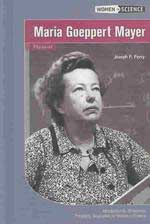.
Maria Göppert-Mayer

Maria Goeppert Mayer
Maria Göppert-Mayer (June 28, 1906 - February 20, 1972) was born Maria Göppert in Katowice, Silesia (then in Germany, now part of Poland) and became one of the two women to receive a Nobel Prize in Physics (the other being Marie Curie).
Biography
Her family moved to Göttingen in Germany in 1910 when her father Frederick was appointed Professor of Paediatrics at the town's university. From a young age, Maria was surrounded by the students and lecturers from the University, intellectuals including future Nobel winners, Enrico Fermi, Werner Heisenberg, Paul Dirac and Wolfgang Pauli. In 1924 she passed the University's arbiter entrance examinations and enrolled there in the fall. Among her professors were three Nobel prize winners: Max Born, James Franck and Adolf Otto Reinhold Windaus. In 1930 Göppert married Dr. Joseph Edward Mayer, the assistant of James Franck. The couple moved to the United States, Mayer's home country.
For the next few years, Göppert-Mayer worked at unofficial or volunteer positions at the university at which her husband was professor -- first at the Johns Hopkins University in Baltimore from 1931-39, then Columbia University in 1940-46, and after that the University of Chicago. During this time, Maria was unable to gain a professional appointment at Joseph's universities due in part to both sexism and strict rules against nepotism. However, she was able to find other research opportunities, including a part-time teaching opportunity at Sarah Lawrence College, a part-time research position with Columbia University's Substitute Alloy Materials Project and Opacity Project, and some time at Los Alamos Laboratory.
During Joseph's time at the University of Chicago, Maria was able to become a voluntary Associate Professor of Physics at the school. In addition, when Argonne National Laboratory came into existence on July 1, 1946, Maria was offered a part-time job there as Senior Physicist in the Theoretical Physics Division. It was during her time at Chicago and Argonne that she developed a model for the nuclear shell structure, work for which she received a Nobel Prize in Physics in 1963 together with Eugene Paul Wigner and J. Hans D. Jensen.
Göppert-Mayer's model explained why certain amounts of nucleons in the nucleus of an atom (2, 8, 20, 28, 50, 82, and 126, for example) cause an atom to be extremely stable. This had been baffling scientists for some time. These numbers are called "magic numbers". Maria postulated, against the received wisdom of the time, that the nucleus is like a series of closed shells and pairs of neutrons and protons like to couple together in what is called spin orbit coupling. This is like the Earth spinning on its axis as the Earth itself is spinning around the Sun. Maria described the idea elegantly:
"Think of a roomful of waltzers. Suppose they go round the room in circles, each circle enclosed within another. Then imagine that in each circle, you can fit twice as many dancers by having one pair go clockwise and another pair go counterclockwise. Then add one more variation; all the dancers are spinning twirling round and round like tops as they circle the room, each pair both twirling and circling. But only some of those that go counterclockwise are twirling counterclockwise; the others are twirling clockwise while circling counterclockwise. The same is true of those that are dancing around clockwise; some twirl clockwise, others twirl counterclockwise."
At the same time, there were German scientists working on exactly the same thing. After they had published their results, Maria sought to collaborate with them. One of the German team, Hans Jensen, worked with Maria to produce a book in 1950 called Elementary Theory of Nuclear Shell Structure. In 1963 both Maria and Hans Jensen were awarded the Nobel Prize for Physics "...for their discoveries concerning nuclear shell structure." Maria was quoted as saying, "Winning the prize wasn't half as exciting as doing the work."
During the 1940s and early 1950s, she computed equations on opacity for Edward Teller that would be used for Teller's investigations into the possibility of a hydrogen bomb.
Death and legacy
Maria Göppert-Mayer died in San Diego in 1972.
After her death, an award in her name was set up by the American Physical Society to honour young female physicists at the beginning of their careers. Open to all female physicists who hold PhDs, the winner receives money and the opportunity to give guest lectures about her research at four major institutions. Two of Göppert-Mayer's former universities also honor her. The University of Chicago presents an award each year to an outstanding young woman scientist or engineer, and the University of California, San Diego hosts an annual Maria Goeppert Mayer symposium, bringing together female researchers to discuss current science.
In literature
She has a small role in the novel Timescape by Gregory Benford.
Links
Retrieved from "http://en.wikipedia.org/"
All text is available under the terms of the GNU Free Documentation License
Retrieved from "http://en.wikipedia.org/"
All text is available under the terms of the GNU Free Documentation License

